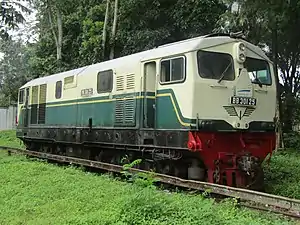Lokomotif BB301
Locomotive BB301 is a diesel-hydraulic locomotive owned by PT Kereta Api Indonesia (Persero) manufactured by Fried Krupp and Krauss-Maffei in West Germany. This locomotive was first ordered by KAI when it was still named Perusahaan Negara Kereta Api (PNKA).
| Lokomotif BB301 | |||||||||||||||||||||||||||||||||||||||||||||
|---|---|---|---|---|---|---|---|---|---|---|---|---|---|---|---|---|---|---|---|---|---|---|---|---|---|---|---|---|---|---|---|---|---|---|---|---|---|---|---|---|---|---|---|---|---|
 BB 301 25 | |||||||||||||||||||||||||||||||||||||||||||||
| |||||||||||||||||||||||||||||||||||||||||||||
| |||||||||||||||||||||||||||||||||||||||||||||
| |||||||||||||||||||||||||||||||||||||||||||||
| |||||||||||||||||||||||||||||||||||||||||||||
This locomotive has an engine power of 1,010 kW (1,350 hp) with a locomotive weight of 52 tonnes (51 long tons; 57 short tons). This locomotive is usually used to tow passenger trains or freight trains, including for junctions. This locomotive can run at a maximum speed of 120 km/h. This locomotive has a B'B' axle, meaning that it has two bogies, each of which has two axles.
This locomotive can be considered the predecessor of the Locomotive BB304. This is due to the same model (Krupp-M1500BB) with a very precise machinist cab design. All BB301 except BB301 51-55 do not have glass at the entrance to the driver's cab and all BB301 have radiator nets in the shape of two upright rectangles.
History
Beginning of service (1964–1995)
Locomotive BB 301 started service since 1964 with 10 units, 1965 with 35 units, and the remaining 5 units in 1970, bringing the total to 50 units. This locomotive has two driver cabins and can go up to 120 km/h (33 m/s). This locomotive reached its golden era during the good times of PNKA-PJKA during the decades 1964 to 1995 because of its experience in pulling superior express trains. The express trains operating at that time were Parahyangan, Bintang Sendja, Djaja, Bandung Express, Bima, Purbaya, and Tumapel.
BB301 has become the main attraction for trains on the main railway line of Java Island, both the North line (Jakarta-Cirebon-Semarang-Surabaya) and South crossing (Jakarta-Bandung-Yogyakarta-Surabaya) so that it became the icon of the Indonesia railways during 1970-1980s. This locomotive is also found in North Sumatra to transport boiler wagons containing fuel oil or palm oil on the Medan-Rantauprapat route. In 1976 to 1984 its sister locomotive was also brought in, namely BB304 so that it could help with BB301 and several diesel-electric locomotives that already existed at that time.
See also
References
- "Indonesian Heritage Railway: Locomotive BB301". Archived from the original on 2014-04-20. Retrieved 2014-07-31.